No Code/Low Code App Development: Perspectives, Essentials, and Concerns in 2025
Updated 26 Aug 2023
20 Min
1922 Views
Software development is a complex process: it constantly requires coding practice and developers’ solid technical background. Various IT tools are being created to simplify the workflow as much as possible. A remarkable breakthrough in this area was made by inventing what is low code/no code platform — a block-based coding system. This building approach has a future; still, there is a number of concerns you should know if you’ve decided to use it.
This article will reveal no-code and low-code app development benefits as well as its challenges, the widely known use cases of such trends, the stats concerning the global low code development platform market, and many other essentials.
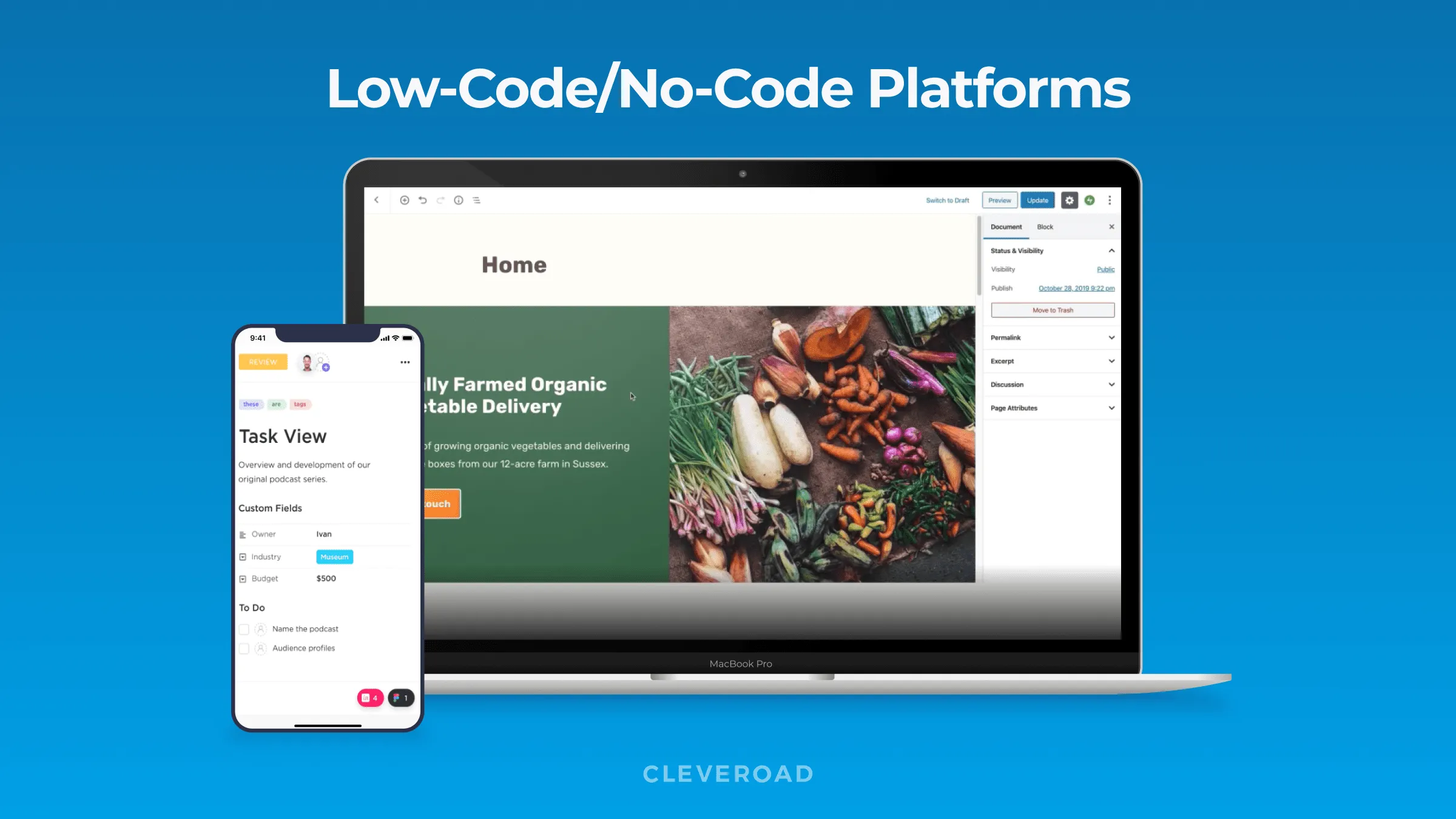
Famous no-code platforms screens
The Low Code Market Overview
What is low code? In a nutshell, it’s a visual software approach that speeds up the entire workflow by providing developers (and even non-developers) with a ready-made user interface on the low-code development platform (LCDP), unlike the entirely hand-coded traditional app building process.
Now, we’ll look at the low code development platform market size. It shows the domain’s growth dynamic, and stats are illustrative.
The low code development platform market is constantly rising. It also happens because of the growing users’ interest in this technology. Statista mentions that the low code development market will gain $65.15 billion by 2027, significantly increasing from the 2020 profit grade of $12.85 billion. Research and Markets resource also positively predicts the future of low-code app development. It states that the upcoming low code market size is expected to reach $187 billion by 2030.
According to Gartner, almost 65% of software building activity will be accounted for by low-code development mechanisms by 2024. Gartner also states that 75% of major corporations would employ at least four low-code/no-code tools for digital application development by 2025 year-end, enlarging the low code market more and more.
What is Low Code App Development?
What is low-code development and why is it important? We’ll take a closer look at it.
Low code platform is a technology that helps users develop software solutions using pre-built code blocks and design templates, and implementing them not only in apps but also in workflows. It decreases customers’ manual efforts to create software products and facilitates the building workflow.
Now let’s consider what is a no-code platform. No-code development platforms (NCDPs) are also technologies available for people with and without a solid tech background, letting them create software via the prepared interface and configuration samples.
To tell more what is no code, we have to reveal the history of its appearance.
The no-code building approach dates back to the 1990s, at the time of the first visual HTML editors’ (such as Frontpage or Dreamweaver) release. Through their graphical interface, the developers obtained an opportunity to facilitate their work. Nevertheless, such editors also required specific skills. WordPress, for example, is quite a simple resource to build sites without any coding; but you should spend time understanding what is no code development and how to properly use it on the example of this platform.
No-code app development started being in-demand in the early 2010s when the online resources began to appear a dime a dozen, and their uniqueness and interface complexity stopped playing a significant role. So nowadays, you can build a website through no-code platforms which would be as good as the complex solution made by hand-coding.
But keep in mind that it is still a great idea to develop custom software due to its numerous advantages. It’s secured, predictable and well-established, leading to unique custom end products. But if you want to speed up the building flow, you can find out what is low code technology and use it according to the principles considered below.
Low-Code/No-Code Development Principles
Though the no-code development approach (as well as low code technology) has a high level of automation, the development procedures and platforms haven’t been robotized yet. As a result, the perfect final product can only come out from the well-coordinated developers’ work. So, what is low code programming/no code programming, and what development principles do the devs use to gain the best results?
Don't forget about the team. Specialists, understanding how to properly use low code explained platforms are essential for a project's success. Product owners, as well as other stakeholders, should be ready to answer the team’s inquiries and evaluate arising challenges.
Follow the business processes and maintain them. Test and review builds, discussing them with other decision-makers knowing what are low code platforms in detail. The low-code facilitates experiments with new functionality or iterations; still, you shouldn't neglect a roadmap and a business plan, as they can help you manage the workflow.
Learn more on how to write an A+ business plan that will help you run the development flow!
Comprehend the low-code platform. Every person participating in the low-code app development process should take part in the low-code platform's evaluation, selection, and implementation, understanding low code meaning, its functionality and requirements. In this case, the time spent learning them will pay off.
Avoid time-consuming customization. The low code platform's predefined components appropriate for many use cases would help you save your time and money expenses. You can also create a reusable custom component during the low code app development to implement it in other apps.
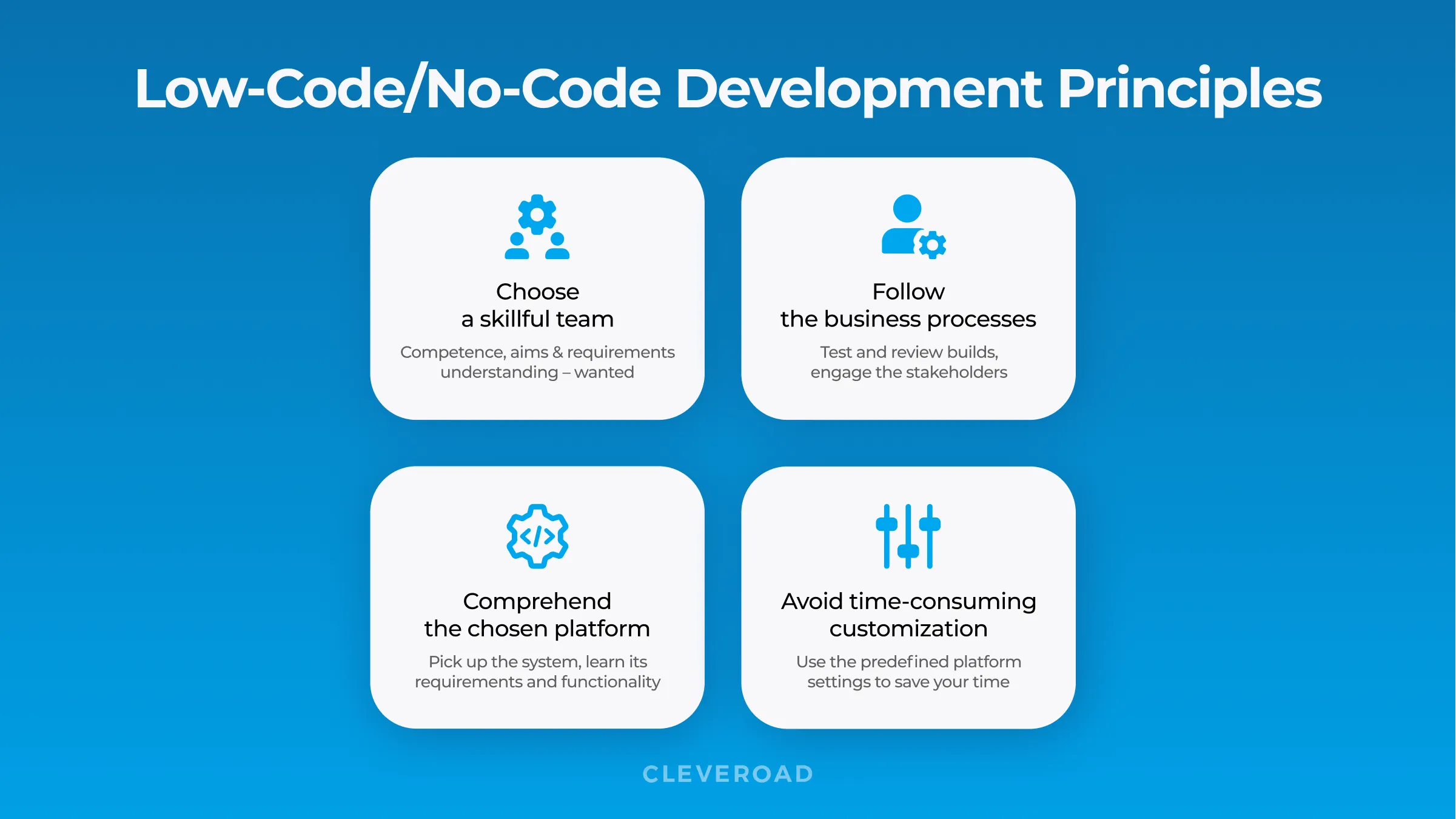
What does low code mean (as well as no code): development principles
No-Code and Low-Code: How to Differentiate?
What is low code automation (as well as no code one) and how to distinguish these two platforms? They are nearly similar at first sight, with their resembling names and common working principles, both being a way for creating a visual app. But these two terms have some distinctions you need to know. We’re going to represent the basic ones that will help you answer the question: what is no code software, and how does it differ from the low code one.
Different purposes. Low-code platforms enable the creation of high-demand apps’ for critical business processes. No-code platforms are suitable for building self-contained solutions for limited business concerns. According to low-code platforms’ purposes, Forrester has divided them into five groups.
- Mobile First — platforms able to help in low code mobile app development
- Database — unique systems intended to store your data
- General Purpose — helpful in multipurpose low code/no code app development
- Request Handling — assisting in dealing with queries
- Process — handling the business processes using low code benefits
The low-code platforms of general purposes are systems that most users find attractive, because they tend to replace such traditional development instruments as .NET and Java.
Need in training. No prior programming knowledge is necessary to use no-code development platforms. Low-code platforms are suitable for those people knowing how to code since they offer more advanced tools (like smart services, drag-and-drop instruments, pre-developed connectors, or components) and support customization. As a result, when it comes to low code implementation, the staff should be more trained to operate.
The core audience. No-code innovations are perfect for any office staff member (even without a special knowledge) to operate with. Low-code systems are not the same things; they require even basic coding skills.
Design. End-users manage no-code basic design applying drag-and-drop logic. Unlike it, low code means following the same development paradigm as high-code solutions that rely on coding to manage an app's basic design.
Other. What is low code/no code platform safety difference? The no-code platforms are less sensitive to vulnerabilities than the low-code ones. It should also be mentioned that in low code vs. high code competition the first ones are 5-7x speedier than the last, the no-code platforms offer 10x-15x faster app creation than it could be during the traditional building flow.
Low Code vs Traditional Development
Each of these two ways is good in its own right. But let’s analyze low code vs high code confrontation, both going by the business requirements. It will help you understand where traditional development is appropriate. You'll also realize when to use low code.
So, traditional app development is vital when:
Your project is technically challenging. Traditional app development is required if there are many factors to be considered. Developing a platform for collective real estate investing on the basis of such stats as return on investment, or housing market value, can be done only with the assistance of a skillful back-ender, who would create a code for all the complex and customized processes or integrations.
Your app requires a non-templated interface. In case you choose a business niche that is already covered, you need to attract your future customer with a solution unseen before. That's why you should search for complex interface elements and build an appealing solution based on customer needs and experience, not low-code templates.
What is low code development, and where would it be appropriate? Here are some common cases:
When you need to build a software solution that’s not labor intensive, like a tiny learning platform, an app for food pre-ordering, etc. Such a well-known site constructor as Tilda offers many bright templates, animation, and HTML coding options. This set allows you to build many small and simple software solutions without much time and money expenses.
When the internal processes of a small company require management. Use no-code/low code tools instead of buying subscriptions to Bitrix 24 or Salesforce. For example, you can create a landing page on Tilda. Google Sheets will be great for gathering requests, as well as CloudPayments — for collecting payments. If you are not in the office, you can send an automatic reply to your partners or customers using MailChimps.
You can learn more about some other differences in low code vs programming from the following table.
| Characteristics | Low-code | Traditional app building |
Prices | Cheaper; paid for the developed service | Expensive staff hiring and app maintenance |
Product quality | No bug-related problems | High bug existence; requires fixing |
Skillset | Hassle free app building | Tools to create a complex app |
Agility | Agile due to drag-and-drop features | Less agile, due to the complicated and large codes |
Maintenance | Created & maintained by the low-code platform owners | Needs in-house team or an outsourced one to develop and run the app |
You can choose an app development way according to your business needs. So, weigh all the pros and cons before you start, and make your choice realizing what is low code development and why is it important.
When to Use Low Code Platform?
In many ways, no-code may help a company's activity and return on investment (ROI) change. Let’s view what is low code development platforms’ application and for what purposes they are needed (as well as no-code platforms).
BI dashboards and reporting. If you're a Business Intelligence analyst or developer, you may discover that no-code technologies are just what you look for. With no code mobile app development, you can obtain real-time access to your company's data and turn it into usable info grids, visualizations, and key statistics.
Data running applications. Customers in the corporate sector may quickly develop database apps connecting data sources to MS SQL Server, MySQL, or PostgreSQL and operate with data. Your built no-code database will have a modular, extendable structure, configurable interface, data export/import functionality, and ready-to-use templates.
Low-code platforms, by virtue of their general-purpose character, enable the creation of more complicated programs and can handle a broader range of use cases, such as:
- Pre-built user interface (UI) designs for mobile customer experience apps that boost user-friendliness and adoption while maintaining brand marketing consistency.
- Modern solutions based on advanced technologies such as AI, ML, or facial/voice recognition built with the help of no code/low code app development systems.
- Apps that cut across departments and domains to boost productivity and efficiency.
Who can create products using no-code/low-code?
These building approaches may be used to create apps both by professional developers and so-called citizen ones — specialists with little coding experience or even without it.
Experienced devs aspire to create innovative software solutions to tackle complicated issues. Developers using low-code have access to a customized IDE as well as a comprehensive toolset suited to their specific needs.
Peculiarities and Benefits of Low Code Development
What is low-code approach’s most important limitation? They not only ignore the notion that applications must evolve, but they also omit the fact that technology is likewise in flux.
That's why, in order to meet the load of rapidly developing and updating commercial and consumer apps, you'll need a strategy that goes beyond low code definition. Yes, low-code may be used, but keep in mind that it should also conduct debugging, automate packaging mobile products for app stores in a single click, and automatically modify settings to accommodate new technologies.
Now, we’ll look more at low-code/no-code challenges as well as the benefits of low code development (and no code ones).
Low-code/No-code concerns
Insufficient flexibility. What is low level code issue, the most prevalent above others? Even the finest no-code systems have inflexible components, therefore, it's critical to match their capabilities to their functions. When visible components in basic use cases meet business requirements or procedures, they will typically function successfully. But remember: complex solutions, or processes require something more than low-code.
Data protection. With low-code/no-code, you frequently have no control over data protection or privacy, and you don't have access to source code, making it impossible to notice any potential issues. Using low-code solutions to develop code that isn't compliant with existing best practices might be against a company's policy; and it makes no difference whether the developed application is stable.
Stricted applicability. It is vital to assess how long it takes a business user (or a developer) to learn what is low code automation platform, and how it's suitable for their intended business goals. When developers have to deal with these visual component systems for a long time, they face an unclear and inflexible system without general applicability. A way to understand whether a platform requires extensive coding to work is the number of developers offering their services to handle such a platform.
Limited performance. Low code development definition includes efficiency — one of the key characteristics since it saves time. But the truth is that it is only successful in the short run. Low-code systems aren't usually built to be high-performing. The amount of low-code platform functionalities is limited: once a low-code program is established, it's tough to add custom code or other essential features.
Integration problems. Using a low-code solution will almost probably lead to future issues connected to integration. As a result, when it comes to key business processes, you simply cannot afford to trade custom integration for speed.
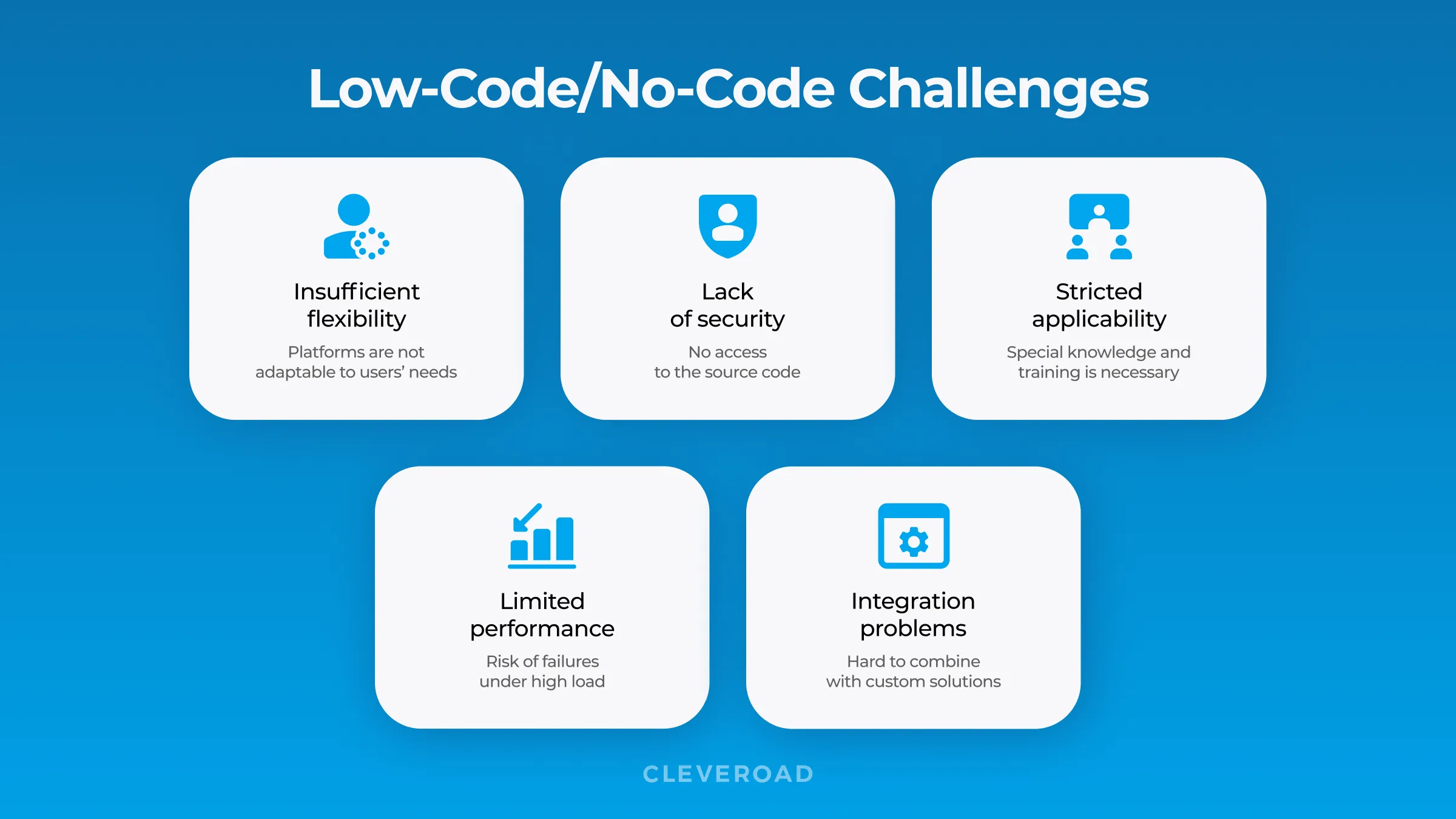
What is low code platform and no code one challenge set to resolve?
We looked at situations when not to use low code as well as no code technology. However, the picture would be incomplete without talking about the benefits of such platforms.
The Advantages of Low-Code/No-Code Solutions
The low code advantages are apparent, ranging from higher efficiency to simplified maintenance. These features are intended to assist business users in increasing the productivity of their workspaces without sacrificing the platform's usability. So, what is low code software development set of advantages (and no code one)?
Cost and time savings
Software professionals are not only difficult to locate, but also expensive to hire. Additionally, traditional app development may be costly for your company in terms of both building and support charges. In this case it's more cost-effective to use a no-code development platform. As a consequence, employing technology saves time, which translates to money saved and enhanced overall profitability.
Fast deployment
What does no code mean for your development flow speed? Your company may build an application up to ten times faster using a no-code platform. No code's drag-and-drop capability allows for quick prototyping. You can establish delivery more quickly than via traditional development platforms.
Fast prototyping
What is low code app development one of the best features? Due to its simplicity, non-coders can quickly prototype their design concepts and make prototype-based interfaces. The final products may be tested, reviewed, and updated without the involvement of traditional software development personnel. Competing solutions can be compared, rejected, or merged until they're ready to be passed on to development for more effective execution.
More automation in less time
When low-code systems are combined with adequate DevOps tools, the low code development meaning may increase. It would speed up the completion of activities and end-to-end procedures, since workflows may be started in response to corporate events, templates can be used to quickly create new processes, and flow control may simplify cross-platform data management. Meanwhile, preconfigured interfaces and API access allow practically any online business function to be automated.
Quick iterations
The demands of the business world are always evolving. Low-code development platforms can help achieve these goals by offering tools for quickly iterating and changing existing processes. The changes can be easily done due to revision history, and noted in the documentation, so it wouldn't be hard to restore them in case something goes wrong. Testing operations can also be used to make sure solutions are ready for launch.
Faster development and innovation
Low-code app creation enables non-technical people to build software while also cutting down on development time. Nonetheless, mobile app developers must ensure that good security and in-app protection are always built-in from the beginning of the design process, rather than being overlooked just for speed or convenience.
The Best Low Code Development Platform: What to Choose?
These low-code/no-code platforms may help you design, launch and upgrade apps quickly. There are a lot of such systems, but we'll highlight the best low-code development platforms, and no-code ones as well as their features and price options.
Creatio
Studio Creatio is a low-code and workflow solution designed for low code app development with a wide range of templates. It provides ready-to-use apps that extend the possibilities of the platform. Studio Creatio also provides tools that let clients engage more efficiently (e.g., create flow diagrams, save them in a process library) and deliver services faster.
English, French, Ukrainian, Russian, German, and other languages are supported by this low-code platform. Enterprise mode of the platform is also accessible, which provides more powerful capabilities for your company flow. This option is available for a free trial period, after which you will be charged $25 per month.
KissFlow
KiSSFLOW- BPM & Workflow Software offers a cloud-based solution that can be applied by companies of all sizes and in any industry. This platform lets you use low code benefits to build customized apps with the help of 45 pre-installed templates and automate company processes. Just drag-and-drop important components if you would like to create or change tasks, logic, and so on.
Before you start using this platform to digitize your requests and flow, you need to choose one of the three pricing models (Basic, Advanced, or Fully Loaded) that is appropriate for you. You can also agree on a Custom pricing model with the Kissflow sales team.
SalesForce
Salesforce Lightning is a platform for developing secure mobile applications. You may easily construct apps in any programming language or even from a spreadsheet with the Pro-Code tools. AI and IoT connection, as well as Salesforce and third-party data integration, are all included.
Developers can construct apps integrating both customized and standard elements on the platform with the support of such a low-code app development platform. It also contains characteristics that assist in the production process's speed.
ClickUp
ClickUp helps to build software for project management, tasks, reminders, documents, timelines, communication, or remote staff running. This platform includes a number of predefined components, contact management capabilities, automated document import from other applications, and other low-code development tools.
ClickUp provides customers with free storage services (about 100 MB) and an unlimited amount of tasks. They also provide an Unlimited plan ($5 a month per customer) containing a number of dashboards, integrations, and so on; Business plan ($9 a month per user) including dashboard widgets, goal folders, Google SSO, or mind maps. There's also an Enterprise plan with individual onboarding and training, enhanced API limitations, and other advanced capabilities.
Bubble
Bubble takes care of the web hosting and product launch, giving you total creative control over your app design. You don't need any CSS or HTML skills to do it.
The volume of data that can be kept, the amount of traffic that can be delivered, and the number of users that can be accessed are all endless. It's fully customisable and serves as a scalable basis for multi-user applications. Bubble allows you to prototype your idea before investing, which is why small businesses use it for web development.
Bubble has three membership plans: personal ($25 per month), professional ($115 per month), and production ($475 per month), each with its own set of tools and settings.
Airtable
Airtable is a data management tool that can be used by any company or marketer. It allows you to add checkboxes, links, files, and barcodes to spreadsheets and databases. It's almost like a workflow and project management tool, but with a lot of different applications. It may also develop graphics for various use cases and save them for quick access when needed.
You may connect your integrated workflow to the data and add its 50+ pre-built applications for convenient administration. These applications have a mobile and web-friendly user experience that allows users to collaborate in real-time on any device.
A free subscription from Airtable includes unlimited bases, 1,200 records, and 2GB of attachments per base. Based on your team's and business's demands, you may upgrade to one of further subscription plans.
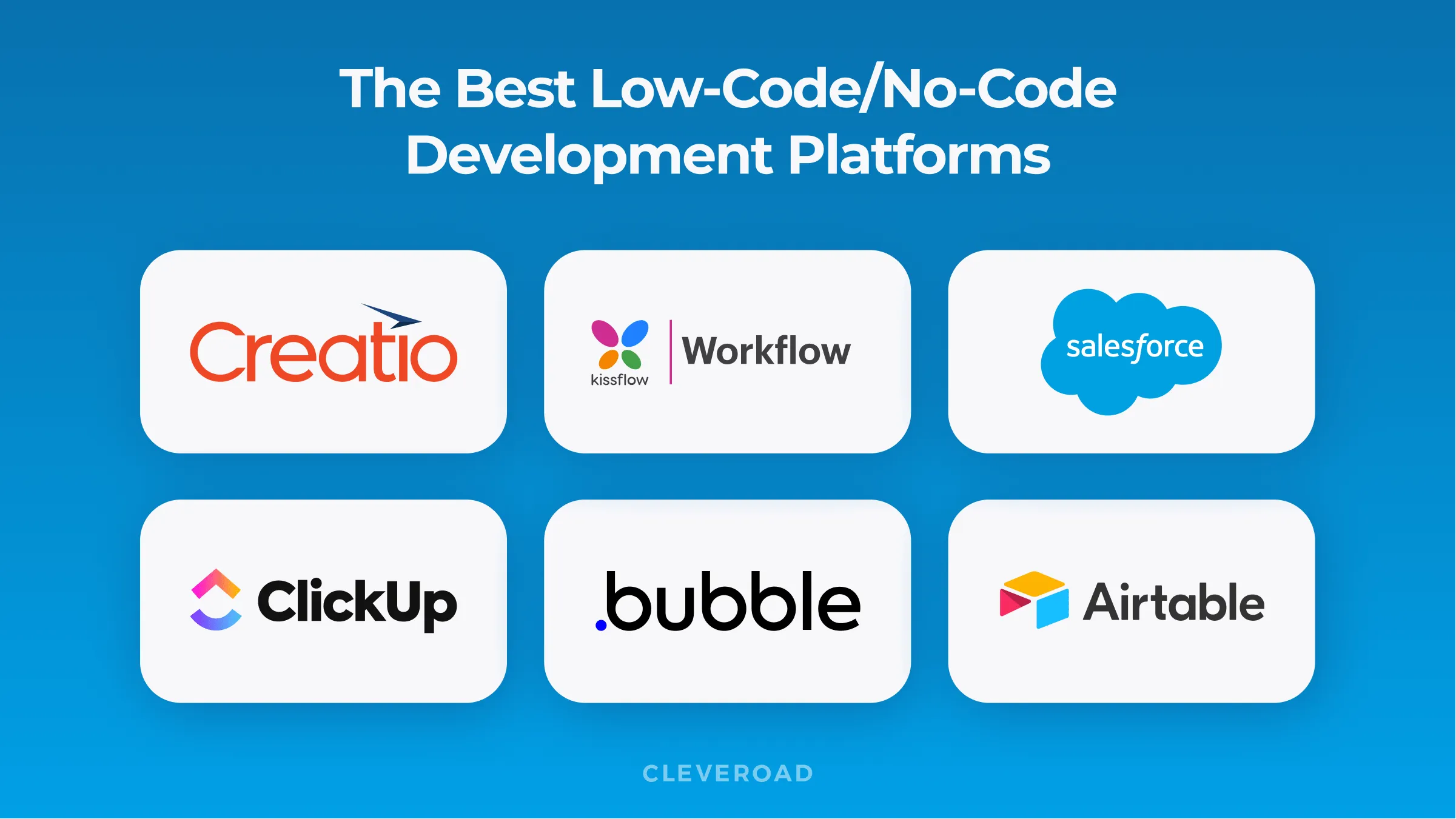
What is low code and no code: The best dev platforms samples
No-Code App Development: Preparation and Workflow
A low code platform definition seems to be far more accessible than a traditional one. But you should also seriously prepare for it, if you want to obtain a product matching your business needs. We’ll tell you how to do it properly and get the desired result.
Before You Start
Only determining low code development platforms definition and choosing an appropriate no-code/low code system to work with is not guarantee of a future success. First off, you should begin by working on your business goals. Make a little brainstorm, asking yourself the questions including:
- What is the business issue to be resolved?
- Is my software the most effective way of resolving the issue?
- If it is, what features and functions should be contained in it?
- What is the relationship between those features and functions and a demonstrable influence on the business outcomes?
This analysis may help you understand where you should focus, what business niche to choose, etc.
Now, you may complete a list of business processes that will influence the desired end result. This stage is all about assessing where you are now and planning for the rest of the project. The objective is to maintain a high level of performance while gathering feedback. You and your colleagues have discovered a problem. What are all of the business processes or workflows that are involved in that issue now?
For example, after the end of each sales quarter, you could have seen that you're losing transactions because your team isn't cooperating on contract conditions quickly enough to acquire a final signature from the customer. Your transaction terms review process, legal review, customer onboarding, and many more workflows might be on the list.
When you define the needed processes to gain a business aim you need, you should put it down on a road map and follow it. You can also prepare a business plan to pass through the processes to your required outcome.
Now, you can establish a broad budget range and a return-on-investment (ROI) criteria. Along with setting such a range, be open to suggestions from experts and vendors (if you decide to outsource software development process and use all its benefits) that may be more costly upfront but can save you a lot of money in the long term.
Read our new outsourcing guide and find out why you should outsource your app development to Ukraine!
If you would like to work yourself on your future low-code/no-code solution, you need to answer the question: what is a low code application platform that will help you develop a new product. The goal is to find the right technology at a reasonable cost to meet the complexity of your workflow, the capabilities of your team, and the changes you foresee in the future.
Keep in mind that you shouldn’t only answer the question of what are low code apps appropriate to build your own solution but verify their concept. It isn’t enough to use the free trial period or watch a webinar from a platform owner. Some low-code/no-code vendors offer one or two free phases for users to understand whether it would be convenient and profitable to work with their platform. But if you (or your project team) have already defined what are low code tools or are ensured in the chosen toolset or system, you can start using it without such verification.
Development Process
If you decide to build a solution yourself, having answered the question of what is no code platform, you can further follow three building steps described below on the example of the Kissflow platform.
Choose a needed interface. You may structure the theme to choose custom color schemes, corporate logo uploads, font type selections, and even custom icon uploads.
Add content. For example, each app prototype in the Kissflow collection comes with pre-configured content that you can quickly modify to meet your specific requirements. Editing, removing, and adding content to your app is simple. Click to alter some features or choose from over 20 pre-build powerful applications to customize your app further.
Launch your product. Now then you've concentrated on the UI and applied your features to each component of your app, all that's left to do is launch it and tell the world about what is a low code development platform (or a no code one) that can fulfill their needs.
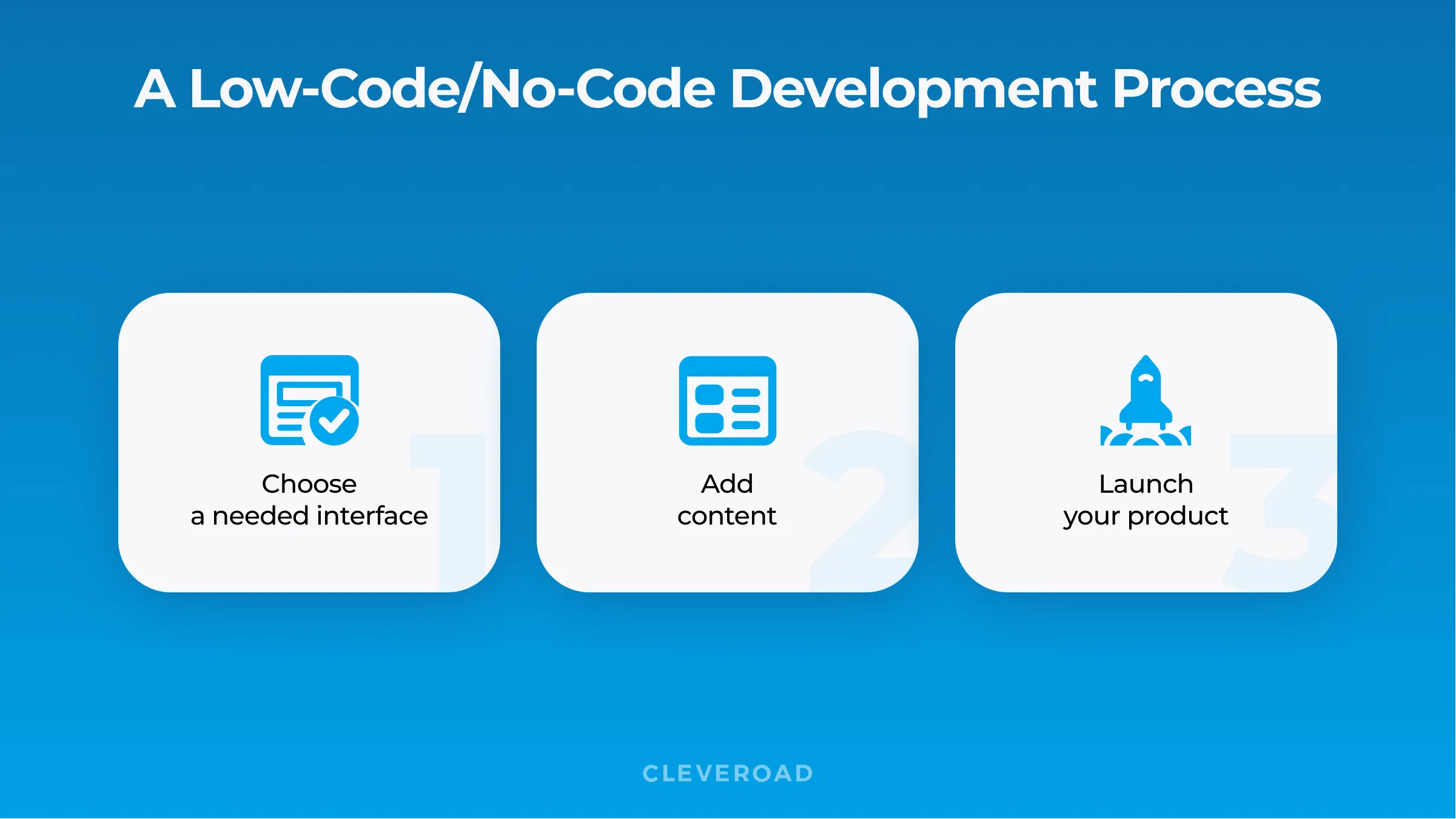
A no-code app development/low-code app development workflow
Light-Speed App Development With Cleveroad
Setting about the work, you should keep in mind that even the best no code development platform contains a lot of code inside. So, it’s up to you — continue working yourself, learning the peculiarities of the chosen systems and facing concerns, or entrusting the app development to specialists. If you want to know more about what is low code software and decide to work with a team of competent IT specialists, we’ll tell you more about Cleveroad.
Cleveroad is a highly qualified application development company established in Ukraine, Eastern Europe. We've been assisting startups and organizations of all kinds in adopting cutting-edge solutions and technologies for 10+ years.
We specialize in a wide variety of IT services that increase workflow efficiency, address business issues, and aid in the acquisition of competitive advantages, including:
- A free project estimation from our Sales Managers, with no hidden costs or fees
- A complimentary consultation with one of our Business Analysts about your project
- Non-disclosure agreements (NDAs) signing per request
- On-demand services, containing low-code/no-code software building, upgrading, legacy system modernization, MVP creation, post-release maintenance, etc.
- A team seamlessly fitting into established workflows
- Innovative development approaches and a cutting-edge tech stack
The “low code vs no code vs traditional development” choice is always an individual decision. A competent IT consulting company can assist you in taking it. So, let’s cooperate and go onwards and upwards, building the no-code mobile app development solutions (and other software products) that fit your business needs and requirements.
Want to collaborate with us?
Leave us a request, and our managers will get in touch with you as soon as possible!
A visual IT building approach that speeds up the entire workflow by providing devs (and even non-developers) with a ready-made user interface on the low-code development platform (LCDP) is called low-code programming.
No-code development platforms (NCDPs) are also available for people with and without a solid tech background, letting them create software via the prepared interface and configuration samples.
- Don't forget about the team
- Follow the business processes and maintain them
- Comprehend the low-code platform
- Avoid time-consuming customization
They’ve got differences in:
- Purposes
- Need in training
- The core audience
- The basic design
- Cost and time savings
- Fast deployment
- Fast prototyping
- More automation in less time
- Quick iterations
- Faster development and innovation
There are dozens of them. But our rating includes the following ones what are low code development platforms with the best functionality:
- Creatio
- Kissflow
- SalesForce
- ClickUp
- Bubble
- Airtable

Evgeniy Altynpara is a CTO and member of the Forbes Councils’ community of tech professionals. He is an expert in software development and technological entrepreneurship and has 10+years of experience in digital transformation consulting in Healthcare, FinTech, Supply Chain and Logistics
Give us your impressions about this article
Give us your impressions about this article
Comments
1 commentsYou are posting a very good article. Thanks for sharing this useful article with us. keep posting.